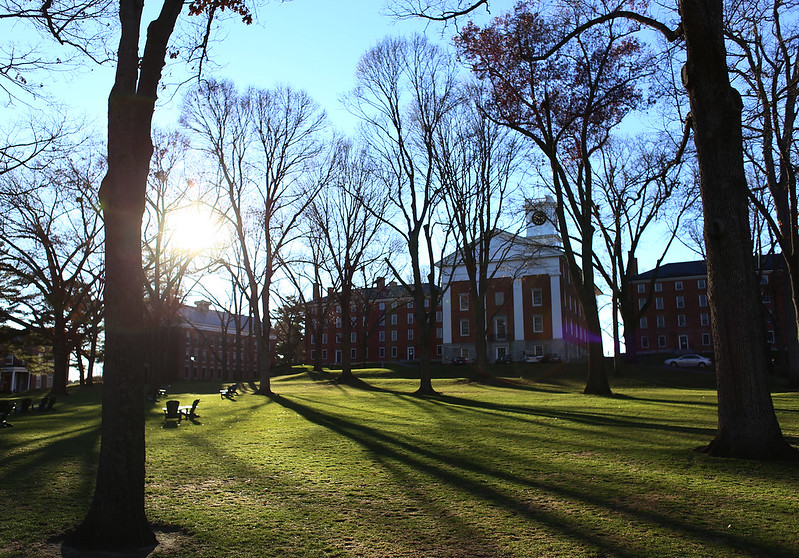
In September 2013, NASA found water on Mars.
According to an article in Science Daily, Dr. Laurie Leshin at Rensselaer Polytechnic Institute stated that “about two percent of the soil on the surface of Mars is made up of water, which is a great resource, and interesting scientifically.”
The news broke all over the country, spurring wild speculation on what this could mean for space exploration. People began to wonder if the presence of water meant the Red Planet could indeed support life.
But if you ask Dr. Jim Holden, a microbiologist at the University of Massachusetts, this information is old.
“It’s been known since Phoenix (a robotic spacecraft that explored Mars in 2008) that there was frozen water on Mars,” Holden pointed out. “That (news) didn’t come as too much of a surprise.”
As a researcher, Holden is interested in extraterrestrial organisms that mirror the microbial life on our own world.
“We don’t know of any other place in the universe with life,” Holden said of using Earth-bound organisms as a model for exploration. “So we can start with these principles first.”
In his lab, Holden studies ecosystems on Earth that he thinks are analogous to environments on ancient Mars.
“The reason NASA is interested in talking to people like me is to learn what kind of life could have lived on the surface of Mars,” Holden said.
In other words, his interest lies in the history of the planet itself.
Specifically, Holden studies deep-sea vents on Earth – hotbeds of microbial activity far below the surface of our oceans. They are unique environments fueled by underwater volcanoes, drastically fluctuating temperatures and the dynamic exchange of nutrient resources. Scientists like Holden believe that similar rock-water ecosystems were common on a younger Mars.
Modern evidence suggests that volcanoes and water were both prevalent on the Red Planet. Therefore, it is likely that there were also Martian hydrothermal vents. By studying the phenomenon of deep-sea vents on Earth, Holden hopes to determine how microbes manipulate minerals through chemical processes and what sort of residue those organisms leave behind. If those same signatures appear on Mars, then it can be assumed that extraterrestrial life existed there for at least some period of time in antiquity.
Holden has worked in tandem with NASA and other colleagues in the Five College Consortium to help find more definitive evidence of life on other planets. One of his primary collaborators is Dr. Darby Dyar. Dyar is a professor of astronomy at Mount Holyoke College who has worked closely with NASA on the Spirit, Opportunity and now Curiosity rover expeditions.
For her part, Dyar uses complex computer science and spectrometry tools to evaluate minerals on Mars. She determines the composition of rocks and other materials based on wavelength emission patterns. But although her interest is primarily in planetary mineralogy, Dyar has nevertheless found common ground with her microbiologist colleague at UMass.
“I’ve been working … with professor Jim Holden in microbiology to look at reflectance spectral characteristics of minerals that have been formed by bioreduction,” Dyar said. “These are really important because they allow us to zero in on areas where microbial life may once have lived.”
For Dyar and Holden, the keys to the future of planetary exploration and the discovery of extraterrestrial life can be found by looking into the past.
“The organisms are long gone, of course,” Dyar said, “but the minerals they left behind, which can have potentially unique spectra signatures, remain to give us clues.”
Through these two scholars, the Five Colleges have already made their mark on the mission to find life on Mars. However, Holden and Dyar would like to take their contribution a bit further.
According to Holden, he and Dyar recently put in an application with NASA to build an astrobiology center that will operate out of UMass. The program will be a five-year, multimillion dollar effort, but Holden hopes that it will serve as a base to focus the local interdisciplinary efforts of everyone from microbiologists to astronomers and geologists.
So perhaps the hype about Martian water should be tempered. However, that doesn’t mean Holden and Dyar aren’t hopeful for the future.
“NASA is currently re-evaluating its priorities for planetary science,” Dyar said. “The new goals are likely to be focused on the issues relating to the processes that formed and shaped our solar system and influenced habitability.”
She added, “Assessing the potential for life elsewhere in our solar system and our universe is an important goal that I wholeheartedly support.
Holden appears even more optimistic.
“Within my lifetime it is very plausible that we will have very good, if not definitive, evidence of life beyond earth,” he said.
But for Holden, whether or not we find life on Mars is a secondary interest. Assuming there is, or was, extraterrestrial life on Mars, Holden still has questions.
“So what then? What are the philosophical or legal perspectives?” he asks.
Holden is concerned with our role as galactic citizens. He believes humanity will be tempted to tap interplanetary resources for personal gain, regardless of the life signs we may or may not find along the way.
“If there are only microbes on Mars,” he wondered, “is it OK to do whatever we want to the planet?”
Søren Hough can be reached at [email protected].


















